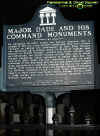| |



The Saint Augustine National Cemetery is full of
many veterans known to the Saint Augustine area for their acts of heroism.
The Cemetery is located near the Florida National Guard Headquarters and
its first internment occurred in 1828. The grounds at one time were that
of an old Spanish Period Franciscan Monastery. The facility then became a
national cemetery in 1881 and the building next to it a military
barracks.
The walls of the Barracks were once part of
the Franciscan Chapel and our Lady Of The Immaculate Conception
established by the Spanish. In 1599 before these walls rose the site was
burned down and rebuilt. Then in 1702 the English forces burned this
barracks down again.
Many years this place was called the St.
Francis Barracks of course the British used them for housing in 1763
to 1783 and Spanish from 1783 to 1821. When FL was given to the United
states the property was leased as a military headquarters for the United
States. The main building was renovated and gutted in 1915 only leaving
the coquina shell. In 1921 they were turned over to the state of Florida.
Today the barracks and military reservation house the headquarters and
military department for the state of Florida and National Guard. There is
security and the cemetery is in the barracks backyard and yes I did give
it a go and was able to get off a few photos for our fans.
Remains of the soldiers along with Major
Francis Dade in 1835 were brought here and buried in one of the three
pyramids in the cemetery. If you want to learn about the Dade Massacre we
also visited the battle field where this took place by Clicking
Here: Dade Battlefield otherwise further below is a more in depth
history of the cemetery which I did not write but it can be used for the
viewing of educational purposes only.
Today the cemetery sits with a wall around it
and wrought iron gates their is security believe me at this cemetery and
its not as large as you would expect. There is a few hundred burials
sitting near small inns, large Victorian homes, and other historic
buildings.
The cemetery is said to be haunted by the
locals I would love to speak with some of those local residents who have
homes with balconies overlooking the graves here.
©
By
Lord
Rick-AngelOfThyNight












HISTORICAL
INFORMATION
http://www.cem.va.gov/CEM/cems/nchp/staugustine.asp
St. Augustine National Cemetery is located in St. Johns County, in the
city of St. Augustine, adjacent to what is now the headquarters of the
Florida National Guard.
Although the St. Augustine burial ground was not designated a national
cemetery until 1881, this hallowed site played a vital role in the
colorful history of the oldest city in the nation. St. Augustine was
originally established in the 17th century as a Spanish colonial
possession. The land that is now a national cemetery was part of a
Franciscan monastery, and the southern boundary marks the periphery of the
old Spanish-walled city. During England’s rule of Florida from 1763 to
1783, the monastery was occupied by the military. During the second
Spanish occupation of Florida, from 1783 to 1821, the property remained in
the hands of the military.
When the United States gained possession of Florida in 1821, the old fort
barracks was set aside for a post cemetery. According to historical
records, the first interment took place in 1828. Most early burials were
soldiers who died during the “Indian War,” either in battle or due to
sickness and disease—not uncommon in Florida’s subtropical climate.
The native Seminoles resisted the U.S. government’s attempts to forcibly
remove them from their territory and seven years of fighting ensued.
On Dec. 23, 1835, Maj. Francis L. Dade and his company were ordered to
reinforce Gen. Wiley Thompson’s troops stationed at Fort King, Ocala.
During the trek from Tampa to Fort King, Dade became lost and announced to
his men that they had successfully passed through Seminole-controlled
territory. As a result, he failed to take appropriate precautions. The
heavy winter garments of the soldiers covered their weapons, so that when
the Seminoles staged an attack, Dade's troops were virtually wiped
out—only one soldier purportedly survived. A few months later, when
travel in the area was again possible, the massacred soldiers were buried
at the site.
In 1842 when hostilities ceased, the Army proposed to transfer the remains
of all who died in the territory, including those who fell with Dade, to a
single burial ground. Reinterment took place at the St. Augustine Post
Cemetery. In addition to Dade's command, more than 1,400 soldiers were
interred in three collective graves. Three distinctive pyramids
constructed of native coquina stone were erected in their memory, as well
as several nearby plain white markers to designate the graves of Seminole
Indian scouts.
When Florida became the 27th state in the Union in 1845, the city was
already developing as a winter resort, offering a warm climate that
attracted northern visitors. Florida seceded from the Union in 1861 and
Confederate troops raised the fourth flag to fly over the city; sentiment
in St. Augustine was about equally divided between the North and the
South. The Confederate army appropriated Fort Marion and St. Francis
Barracks.
The city suffered greatly under federal blockades, and in March 1862 when
a Union gunboat entered St. Augustine harbor, the mayor quickly
surrendered. It was again a permanent part of the Union. Two decades after
the Civil War, St. Augustine again flourished and the commander of St.
Francis Barracks recognized the need to assure the proper care and
respectful treatment of the old post cemetery. That same year,
Quartermaster Gen. Montgomery Meigs proposed that "As Florida is now
a resort of many thousands of citizens with their families in search of
benefit from its mild winter climate, it will only be becoming to put this
cemetery, too long neglected and falling lately into decay, into as good
condition as the other national cemeteries." The adjutant general
concurred, and the post burial grounds were declared a national cemetery.
At this time it was also proposed that a monument be erected to the
soldiers who died in the Florida wars. It would be a tall obelisk to stand
before the three pyramids, the cost of which would be met by a donation of
one day's pay from each soldier stationed at the barracks. A wall of
coquina stone was constructed to enclose the cemetery properly. In 1912
and 1913, additional land from the military reservation was added to the
cemetery, nearly doubling its size to 1.36 acres.
In 1938, a new superintendent's lodge was constructed according to designs
approved by the city council, which sought to preserve the unique heritage
of St. Augustine. Built of coquina with an overhanging balcony and shingle
roof, the building was architecturally in keeping with the style of the
old Spanish homes in the historic district. A coquina rostrum at the
northern end of the cemetery, the stage for official ceremonies, echoed
the curving roofline silhouettes of the Spanish Baroque style seen in
other prominent city structures.
In 1970, St. Augustine National Cemetery was included in a National
Historic Landmark historic district that encompasses the oldest part of
the city.
Monuments
and Memorials
The
Dade Monument is composed of three distinct pyramids constructed of native
coquina stone. The pyramids were erected in 1842 and were originally
covered with white stucco. The memorials were dedicated at a ceremony on
Aug. 14, 1842, that marked the end of the Florida Indian Wars. The
pyramids cover vaults that contain the remains of 1,468 soldiers who died
during the Florida Indian Wars, from 1835 to 1842. According to the
inscription, the wars began on Dec. 25, 1835. Three days later, Maj.
Francis L. Dade and his regiment were enroute from Fort Brooke (Tampa) to
Fort King (Ocala) when they were ambushed and killed. Of the 106 men and
officers under his command, only two survived. Maj. Dade and his men are
among those entombed at the pyramids.
The Dade Monument, a coquina stone and marble obelisk, was erected in 1881
and commemorates Maj. Francis L. Dade and the men who died with him at the
1835 massacre. Soldiers stationed at the St. Augustine post contributed
one day’s pay to fund the memorial.
|
|















